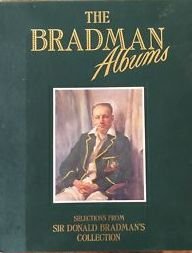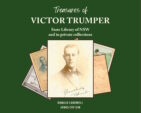The Bradman Albums
Archie Mac |Published: 2017
Pages: 800
Author: Bradman, Donald
Publisher: New Holland
Rating: 4 stars

The Bradman Albums were originally published in 1987 when Sir Donald Bradman was still with us; he wrote the introduction. Since his death in 2001, his legend, if it was possible, has only grown and now 16 years later New Holland have rereleased the two book set albums.
New Holland’s timing could not be better. With the current Australian team struggling and an Ashes series looming it is satisfying to revisit the days when Australia beat all-comers. Their dominance was based on the greatest player the game has witnessed. Bradman rewrote the record books and swelled the attendance at every game he played.
The albums are split into two volumes: the first covers 1925 to 1934, and the second 1935 to 1949. The books feature contemporary newspaper reproductions and illustrations from throughout Bradman’s career. There are also colour inserts printed on glossy stock, throughout. Some of these are personal photos from Bradman’s own collection and include colour photos from his wedding to Lady Bradman.
It’s hard to imagine that even the highly exposed modern sporting stars can have had as much newspaper coverage as Bradman, especially as there was no TV, internet or social media to compete. This meant that the voracious cricket fans had only the radio and their morning and afternoon newspapers to sate their hunger. As it was any newspaper editor’s remit to sell papers they favoured stories on the biggest star of the period – The Don.
It is fascinating to read the early reports on Bradman, or the Boy From Bowral as he was often described. Most included in the albums are positive in nature, even when Bradman fails in his Test début the press still appears to be on his side. Perhaps it is not that surprising as Bradman rarely falters and set the bar incredibly high from a young age.
Like their Australian counterparts the English press is quickly behind Bradman as he constantly plunders England’s bowlers during his first tour in 1930. The Surrey captain Percy Fender was one of the few to openly criticise Bradman in the press, but quickly had to eat his words as the young Aussie whacks Surrey for 252* and ends up posting 974 runs in the five Tests.
For the cricket purists the 1932-33 English Ashes tour – Bodyline – is covered at length. The fervent and indignant response from the Australia media to the English tactics is akin to war. The Aussie press quickly paint the English captain Douglas Jardine and his chief fast bowler Harold Larwood as the villain and Don Bradman as the Australian hero. The first volume finishes after the 1934 Ashes tour where, and it is no exaggeration to write, Bradman comes close to death.
Apart from cricket there are some other huge events during Bradman’s time including WWII – and even though there is minimal cricket, Bradman is still a hot topic. Questions such as which branch of the armed forces he will join and whether he will see action are dissected. In the end Bradman joins the air force but quickly becomes ill and is invalided out.
Bradman’s return to Test cricket after the war was not guaranteed but he decides to play even though he harbours doubts about his own ability. In the end he still dominates and the second volume is a progression as Bradman triumphs and there is no doubt for the contemporary press of the 1940s that Bradman is the greatest ever.
The Bradman Albums are a timeless illustration of what it was like to live through the Bradman era. An added bonus is the quality of the production values. These albums are a must have for every cricket fan.






Leave a comment